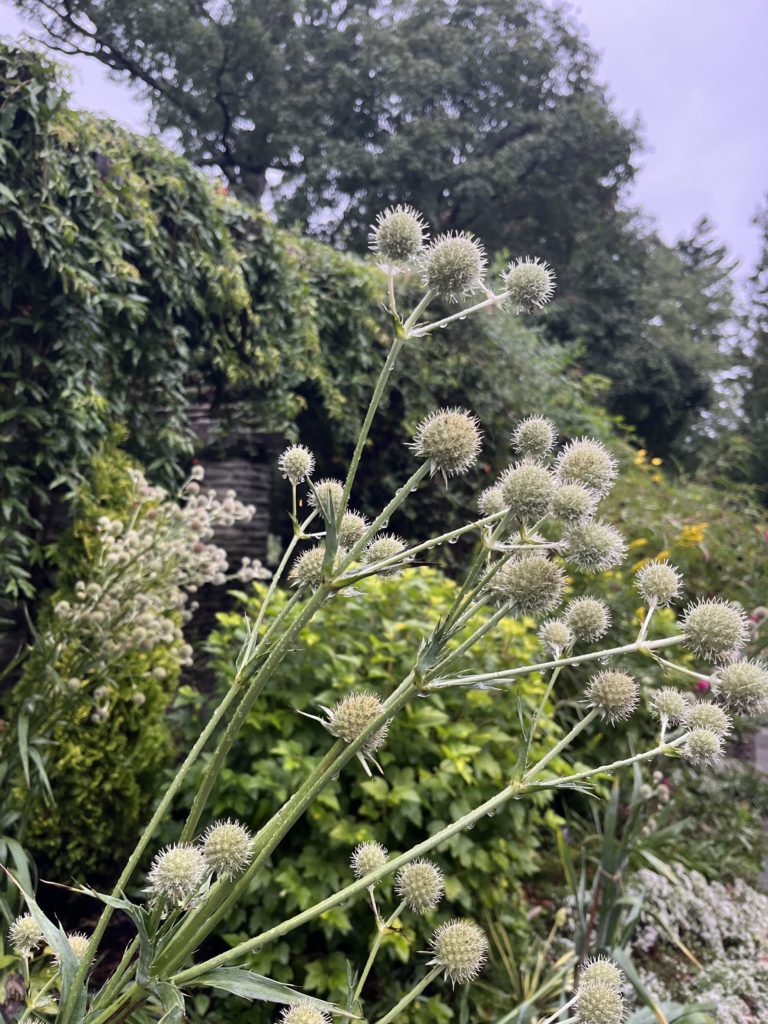Hedges can be boring – in some ways, that’s the point of a hedge. They are a straight line of the same plant, trimmed to a neat shape that creates a dividing line in a landscape and a backdrop for more exciting plantings. That’s all good, but why not mix up the plants in a hedge? That’s a question the gardeners at Stoneleigh, a Natural Garden, in Villanova, PA, asked. Their answer, yea, why not?

I had a chance to tour Stoneleigh during the 2023 Fling, an annual meetup of garden communicators of all types. Stoneleigh has been a public garden only since 2016 when the Haas family donated the property and house to Natural Lands, a regional conservation group. The family home still stands, a glorious Tudor Revival structure that gives off castle vibes. The landscape around it, which was largely designed in the early 20th century by the Olmsted Brothers, sons of noted landscape architect Frederick Law Olmsted, is slowly being transitioned to a more naturalistic garden. Horticulturists at Stoneleigh rely on native plants and the garden demonstrates how those plants can be adapted to home gardens as well as grand landscapes. Stoneleigh features over a mile of paths for visitors to walk, a bog garden, a meadow, stunning old trees (the catalpas form what feels like a secret garden), a vine-covered stone pergola and lots of hedges—most of which are of mixed plantings.

Why Mix Up Your Hedge Planting?
There are many good reasons to include more than one species in hedge plantings. A diversity of plant types is one way to ward off a disease disaster. If you have only one species, a disease or pest could easily spread among the plants, leaving you with a nasty looking hedge and expensive replacement costs. Secondly, a variety of plants can lead to longer seasons of color and more interesting combinations of texture. Most importantly, a variety of native plants are more likely to serve greater numbers of insects, birds and other wildlife, providing food, shelter, nest sites and larval food. It is an ecosystem not just a plant group.
Here are some of the plants in the hedges at Stoneleigh: Arborvitae, pine, American holly, arrowwood viburnum, doghobble, sweet gum, American beech and southern magnolia. Keep in mind, Stoneleigh is located in USDA Hardiness Zone 7a, so considerably warmer than our climate in Minnesota. For larger properties seeking a hedge to block the wind and provide privacy, a mix of evergreens and hardy Minnesota shrubs such as dogwoods, Viburnum trilobum and serviceberry to name a few would provide the same benefits.

Key to Successful Hedge Plantings
If you are planting a mixed hedge, you’ll want to choose plants that have similar light and soil needs. If the area is shady, pick shrubs that can handle a bit of shade, such as black chokeberry or red twig or gray dogwood. In sunny spots, go for plants that like full sun, such as American hazelnut or elderberry. For interest, choose plants with different bloom times and contrasting textures.
If you like things neat, pick plants that can take some pruning or naturally mature to about the same size. When you plant, give each shrub enough room to reach maturity and maybe touch its neighbors but not overtake them. At Stoneleigh, vines are a big part of the mixed hedges. Some climb on an impressive stone pergola, while others wind among the plants.
For smaller properties, this type of hedge planting may be a challenge, but mixing species to create an ecosystem in our yards is a good goal for any gardener.

Excellent post, Mary. I also suggest our native ninebark here in Minnesota (Physocarpus opulifolius, not the many cultivars) with its dense growth and ability to be pruned. Great for pollinators, too.
I totally agree! Ninebarks are terrific for hedging and birds love them.